October 29, 2021
Air Date: October 29, 2021
FULL SHOW
SEGMENTS
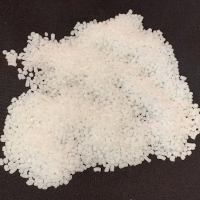
The Climate and Plastic
View the page for this story
Plastic pollution is one of the biggest environmental threats to this planet, and according to a report by the advocacy group Beyond Plastics, greenhouse gas emissions from plastic production in the United States are on track to outpace domestic coal emissions. Judith Enck, a former regional administrator of the EPA and founder of Beyond Plastics, co-authored the report and joins Living on Earth’s Bobby Bascomb to discuss. (12:08)

Vultures in Love
/ Mark Seth LenderView the page for this story
Vultures are not exactly the most charismatic or cuddly of animals but they do have their charm, observes Living on Earth’s Explorer in Residence, Mark Seth Lender. In East Africa, he watches a mated pair of vultures preening each other with ground termites to keep parasites at bay. (02:18)
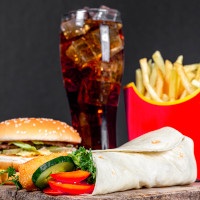
Fast Food with a Side of Phthalates
View the page for this story
Fast food could be even more unhealthy than we knew, as a recent study that sampled fast food items from six major chains found toxic chemicals linked to serious health problems and even early death. Researchers found that at least 70 percent of the fast-food items tested contained phthalates, which are used to soften plastics. Dr. Ami Zota, associate professor at George Washington University’s Milken School of Public Health and co-author of the study, joins Host Steve Curwood to discuss. (09:38)
Beyond the Headlines
/ Peter DykstraView the page for this story
This week, Environmental Health News Editor Peter Dykstra shares a sobering update about declining northern right whale numbers with Host Steve Curwood. Also, an increase in industrial poultry farms is adding to North Carolina’s massive hog waste problem. And in the history calendar, the anniversary of a Midwest blizzard that spurred a mass migration of waterfowl heading south all at once and shut down airports. (05:17)

China’s Energy Crunch and Climate
View the page for this story
Roughly 20 Chinese provinces are enduring rolling electricity blackouts amid a coal and natural gas shortage. Isabel Hilton, founder and senior advisor of the China Dialogue group, joins Host Steve Curwood to discuss the current energy crunch, how it intersects with China’s long-term climate commitments, and the prospects for China’s influence at the UN climate talks. (16:53)
Show Credits and Funders
Show Transcript
211029 Transcript
HOSTS: Steve Curwood
GUESTS: Judith Enck, Isabel Hilton, Ami Zota
REPORTERS: Peter Dykstra, Mark Seth Lender
[THEME]
CURWOOD: From PRX – this is Living On Earth.
[THEME]
CURWOOD: I’m Steve Curwood.
Plastic and its contribution to climate change.
ENCK: As of 2020 the U.S. plastics industry is already responsible for at least 232 million tons of greenhouse gas emissions every year. This amount is equivalent to 116 average sized coal plants.
CURWOOD: Also, phthalate chemicals found in plastic, are common in fast food.
ZOTA: Generally foods containing meats such as cheese burgers and chicken burritos had higher levels of chemicals. And so we’re doing a big experiment on ourselves where we’re allowing our population to be exposed to this chemical.
CURWOOD: Also China at the UN Climate talks. That and more this week on Living on Earth – Stick Around!
[NEWSBREAK MUSIC: Boards Of Canada “Zoetrope” from “In A Beautiful Place Out In The Country” (Warp Records 2000)]
[THEME]
The Climate and Plastic
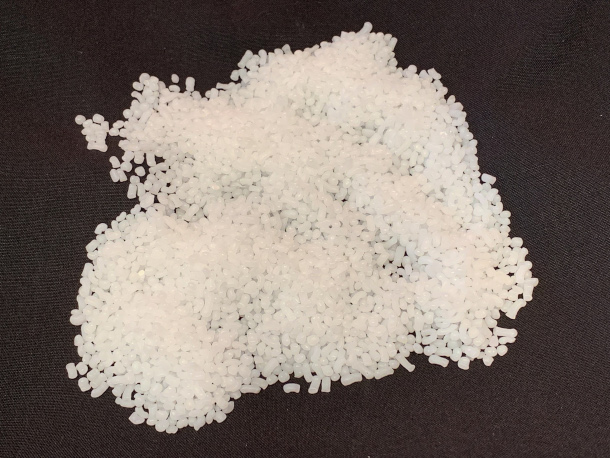
Plastic nurdles are tiny pieces of plastic created by ethane cracker plants and constitute the primary feedstock of plastic manufacturing. (Photo: Mark Dixon, Flickr, Public Domain)
CURWOOD: From PRX and the Jennifer and Ted Stanley Studios at the University of Massachusetts Boston, this is Living on Earth. I’m Steve Curwood.
As many world leaders gather in Glasgow Scotland for a UN Climate Summit, there is yet another factor to consider in facing the climate emergency, and it’s called plastic. According to a report from the advocacy group Beyond Plastics based at Bennington College, plastic production in the US is on track to outpace domestic coal in terms of greenhouse gas emissions. Analyzing data provided by plastic manufacturers to the federal government, the firm Material Research looked at every aspect of plastic manufacturing, cradle to grave, to determine how much plastic is contributing to climate change. They found that in 2020 the plastics industry was responsible for roughly 232 million tons of greenhouse gas emissions, roughly equivalent to those of 116 typical coal fired power plants. And that number is set to increase dramatically as fossil fuel companies continue to invest in more plastic production. Judith Enck is a former regional administrator of the EPA and founder of Beyond Plastics, and co-author of their report titled, The New Coal: Plastics and Climate Change. She spoke with Living on Earth’s Bobby Bascomb.
BASCOMB: So this report really marches through the 10 stages that you outline of plastic production, cradle to grave, starting with hydro fracking. Now, I think a lot of our listeners might be familiar with hydro fracking for natural gas energy but how does that feed into plastic production?
ENCK: Well, they are attached at the hip. It's because of the massive increase in hydro fracking in the United States we're seeing this big expansion of plastic production. What's happening is we have about 1 million hydro fracking sites throughout the country. And at the actual sites, you have methane gas that is vented into the atmosphere is a waste gas, it's never really captured. And what we're seeing at a small number of these sites, but it's still significant, is pipelines are being constructed to capture some of that gas and bring it to new multibillion dollar ethane cracker facilities. These are enormous manufacturing plants, where the gas is heated at very high temperature and then cracked. That's why it's got the funny name of cracker. There's nothing delicious about it and that then becomes the building block of single use plastic packaging. So at these ethane cracker facilities, at the end, you get billions of little pieces of plastic that are used. They're then shipped off to facilities where they make plastic packaging. One of the big problems is the ethane cracker facilities are super emitters of carbon.
BASCOMB: Now you say in your report that expanding ethane gas cracking facilities would add up to another 110 million tons of greenhouse gas in the next few years. Can you tell us about that please?
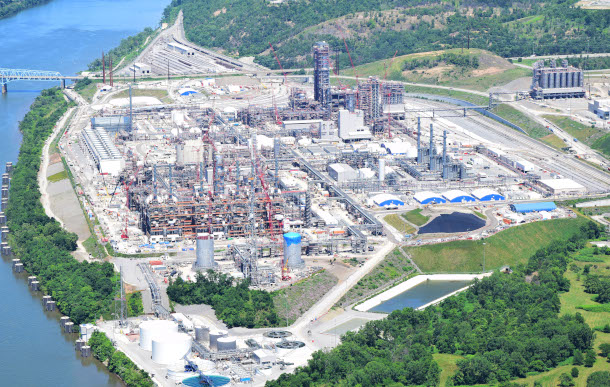
An ethane cracker facility owned by Shell in Beaver County Pennsylvania. (Photo: Ted Auch, FracTracker Alliance, Flickr)
ENCK: Sure. So, ethane crackers are probably what I'm worried about the most on this issue, because they are just so large, and are emitting such huge amounts of not just greenhouse gases but also air toxins and particulate matters for people who live near these facilities. There are currently 35 operating ethane cracker plants in the United States that are emitting 70 tons of greenhouse gases each year. That's the equivalent of 35 coal fired power plants. There are 12 Major cracker expansions proposed at existing locations and there are two really big ones that are poised to start operating very soon. One is owned by Shell in Bucks County, Pennsylvania and then there's a joint venture between Exxon Mobil and SABIC in Corpus Christi, Texas. And then there are another three new cracker facilities proposed. And what people need to realize that when they're these expansions are happening at existing locations, that is adding to the pollution burden of low income communities, communities of color, that already are being disproportionately impacted by this pollution.
BASCOMB: And a lot of these new ethane cracker facilities that are in the works are in an area, you know, colloquially called cancer alley. I mean, this is an area where people are already exposed to a lot of petrochemicals and industry and things like that. So to what degree do you see this as an environmental justice issue?
ENCK: This is probably one of the most serious environmental justice issues facing our nation. As you mentioned, these facilities are proposed in an area of Louisiana called cancer alley. It has that terrible name because of mostly air toxics and water pollution coming from the facility. And I think now we can call it climate change alley, because more than 90% of the climate pollution that the plastics industry has reported to the EPA occurs in only 18 communities. And this is mostly along the coastline in Louisiana, and Texas, and these are almost all low income communities and communities of color. And so we see the clustering of facilities. It's almost like the federal and state regulatory agencies have decided that there are sacrifice zones in our country. You already have a lot of petrochemical facilities so more are being added.
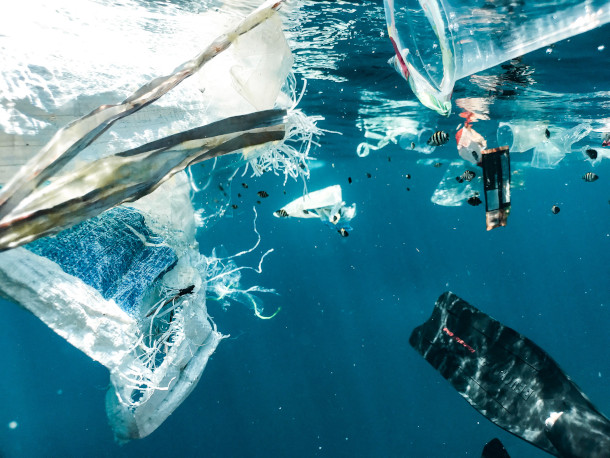
Plastic kills and endangers wildlife from birds to fish and there are estimated to be about 269,000 tons of plastic in the ocean. Invertebrates are especially susceptible; for example, when oysters eat plastic their immune system is weakened, thinning out their external shell and making them an easier catch for predators. (Photo: Naja Bertolt Jensen on Unsplash, Creative Commons)
BASCOMB: Well, why is plastic production increasing so dramatically? I mean is there really an increasing demand from consumers for more plastic? Or is this possibly more driven from the fossil fuel companies that make the raw material for it?
ENCK: It's absolutely not being driven by consumers. In fact, data is showing that consumers are looking for alternatives to plastic and it's hard when you're in an American supermarket, no matter how careful you are. This is happening because plastics is the plan B for the fossil fuel industry. Most of the fossil fuel profits come from two big businesses. One is electricity generation. And what's happening there? We're finally seeing a significant shift toward energy efficiency and renewable energy projects like wind, solar, small scale, hydro, geothermal. So the fossil fuel folks knew a long time ago that that shift away from relying on fossil fuels for power was reducing. At the same time, their second big profit center is transportation fuels. Well, what's going on there, we're electrifying more and more people are buying electric cars. big truck fleets are eventually switching over to electric vehicles. So the fossil fuel industry knows that their market for electricity generation and transportation is reducing. So that's why I say they are counting on plastics as being their plan B as their big market share. And there's already a lot of integration between chemical companies and fossil fuel companies. A lot of the names we recognize not only make fossil fuels, they also make chemicals. So unless you live in a community where one of these ethane cracker facilities are proposed, or a new pipeline is proposed, there's really not much general awareness that this is happening.
BASCOMB: Well the other end of the lifecycle of plastic is either recycling incineration or landfill generally, can you tell us about the greenhouse gas emissions associated with with each of those outcomes?
ENCK: Well, very little from recycling, thank goodness. But as I've said on your show, before, people should really only be recycling number one, and number two plastics and in a few communities, number five, because most plastics are not recyclable. Over 90% of plastics are not recycled. If plastics go to a landfill, they typically are not releasing greenhouse gases but they sure are if they are going to garbage incinerators of which there are about 75 In our country. So if plastic is burned at municipal waste incinerators it's releasing about 15 million tons of greenhouse gases a year which is about seven average sized coal fired power plants. And then I would add, when you burn plastic you also get dioxin emissions and other, other contaminants.
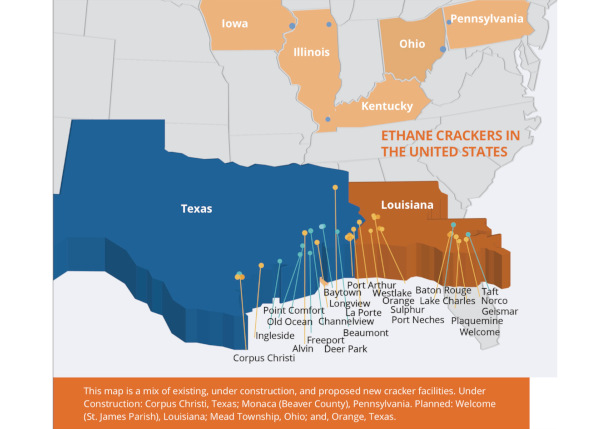
According to the report by Beyond Plastics, more than 90% of the climate pollution that the plastics industry reports to the EPA occurs in 18 communities, mostly along the coastline of Texas and Louisiana. The image above points to the area of ethane cracker facility concentrations, with blue dots showing existing facilities and red and orange showing proposed. (Photo: Screenshot of The New Coal: Plastics and Climate Change by Beyond Plastics report)
BASCOMB: Now, President Biden has set a goal of slashing greenhouse gas emissions by 50% in the next nine years by 2030. How do you think plastic production should fit into that agenda? And for that matter, what is the Biden administration doing in terms of addressing plastic pollution and greenhouse gas emissions from plastic?
ENCK: They're doing virtually nothing. So right now, I would say the issue is missing in action. And we're going to be working very hard in the months ahead, to get plastics on the climate change agenda, both at the state and federal level. And I might add, we're going into the COP26, United Nations convening for a couple weeks in Glasgow, Scotland and I've scoured the agenda for Glasgow and I do not see plastics on that agenda at all. And the United Nations has been really putting a spotlight on the problem of plastics in the ocean. They've released some very important data on this, but even the UN is missing the whole lifecycle. Such a sophisticated, important body, but they're really just focused on the end, the massive amount of plastics that get into rivers and oceans. And our life work now is to get these bodies to focus on production, use and disposal. So we view this report was a clarion call to policymakers and businesses. Yes, let's keep working, driving down greenhouse gas emissions wherever we can but don't leave plastics out of the equation, because then we're going to be regretting that all of our good hard work to phase out fossil fuels for energy and transportation may get canceled out with this uptick in plastic production.
CURWOOD: Judith Enck the founder of Beyond Plastics, speaking with Living on
Earth’s Bobby Bascomb. And Bobby joins me now for more. Hey there Bobby.
BASCOMB: Hey Steve! So we reached out to the fossil fuel companies Judith mentioned here: Shell, Exxon, and SABIC but we didn’t get any responses about this report. The Plastics Industry Association though told Waste 360 that “it’s no surprise that an organization named Beyond Plastics would cherry pick data to fit their narrative.” And they go on to defend plastic saying it’s more light weight than alternatives including glass and metal. So, they claim plastic uses less energy and has lower carbon emissions.
CURWOOD: Ok, well thanks Bobby.
BASCOMB: Sure thing, Steve.
CURWOOD: That’s Living on Earth’s Bobby Bascomb.
Related links:
- Reach the report by Beyond Plastics The New Coal: Plastics and Climate Change
- Read a report by The Plastics Industry Association
- Rolling Stone | “Report: Plastic May Soon Overtake Coal as a Climate Killer”
[MUSIC: David Buchbinder, “Walk To the Sea” on Walk To the Sea, by David Buchbinder, Tzadik-A Project of Hips Road]
Vultures in Love
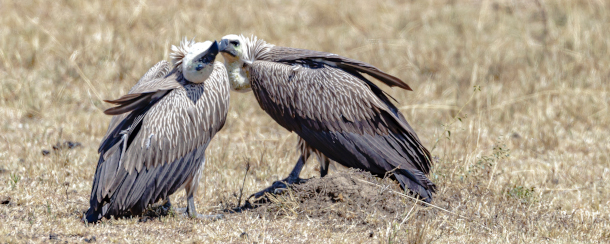
Two vultures preen each other. (Photo: © Mark Seth Lender)
CURWOOD: Vultures are not exactly the most charismatic or cuddly of animals but they do have their charm observes Living on Earth’s Explorer in Residence, Mark Seth Lender. In East Africa, he watched a mated pair of vultures preening each other with ground termites to keep parasites at bay.
"Vultures in Love"
White-backed Vulture
Near the Sekenani River, Maasai Mara
Author's Note
Some birds have an interesting use for ants or more likely, the formic acid ants themselves use as a defense. They sit on an ant hill with feathers spread and presumably the ants feast on the parasites feasting on the bird. Sometimes birds crush the ants onto their feathers and skin using the formic acid directly. Both practices are called anting. Another method for removing parasites is called allopreening, where one bird preens the feathers of another. Recorded here is an instance of African white-backed vultures combining both strategies – allopreening and anting - and not with ants but termites.
LENDER: Out on the open plain, two vultures stand side by side. The day is coming to an end (on at the equator night comes like a slammed door. Atop an acacia tree they would be out of harm’s way. Yet they remain. One of the vultures is on a small bare hummock that mounds up out of the close-cropped grass. The other bends down, and takes something from the base of the mound with the tip of his beak. The vulture on her slight perch does the same:
Bend.
Pick.
Up again.
Down again.
Now him…
Now her…
Now both of them.
Then:
Stropping brushing stroking each other with their beaks, rapid, intent, along the check, deep between the shoulders, burying their faces in the collar that forms a ruff about each other’s throats –
– rubbing something in.
The thing that each has retrieved from the mound?
There.
There it is.
Inside her open mouth.
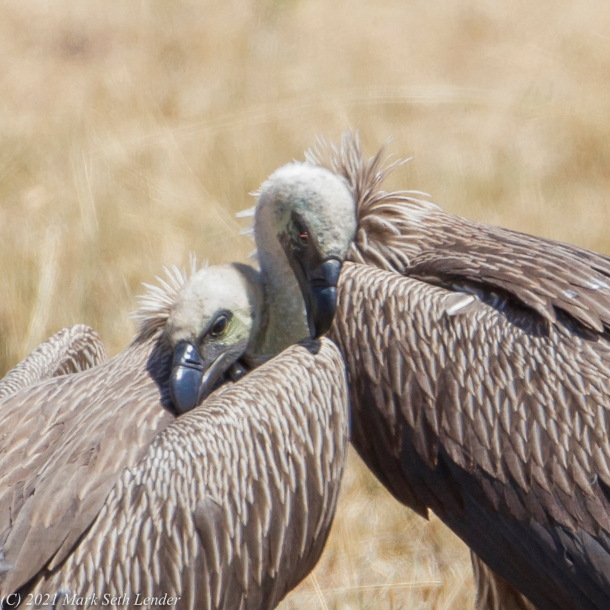
Two vultures preen each other to keep parasites at bay. (Photo: © Mark Seth Lender))
The creamy white body of termite, bounced against the hard palate, the black tongue lifting pressing crushing. He has one also. And using their beaks like burnishing tools they spread the masticated stuff deep inside the many-layered coats of each other’s feathers.
And stop.
And look into each other’s jet black eyes.
Their mouths open, barely, as if speaking, as if his murmurings only for her, hers meant only for him.
And start again:
Combing roaming clutching.
Necks entwined.
Beaks touching.
And touching.
The light fails but they never will.
Vultures, in Love!
CURWOOD: Living on Earth’s Explorer in Residence, Mark Seth Lender
Related links:
- Find the corresponding Field Note for this essay
- More from Mark Seth Lender
- Special thanks to Destination Wildlife
[MUSIC: Walking in Music, “Next Generation” by Gary Burton, Concord Jaxx Label]
CURWOOD: Coming up - fast food with a side of toxic chemicals. That story is just ahead. Keep listening to Living on Earth.
ANNOUNCER: Support for Living on Earth comes from Sailors for the Sea and Oceana. Helping boaters race clean, sail green and protect the seas they love. More information @sailorsforthesea.org. Support also comes from Friends of Smeagull the Seagull and Smeagull’s Guide to Wildlife. It’s all about the wildlife right next door to you!
That’s Smeagull, S - M - E - A - G - U - L - L, SmeagullGuide.org.
[CUTAWAY MUSIC: Luminosity, “Voodoo Chili” on Back of the Moon, by Robertsons (H. Napier), Mad River Records]
Fast Food with a Side of Phthalates

The study analyzed hamburgers, fries, chicken nuggets, chicken burritos, and cheese pizza and found detectable levels of plasticizers and concerning orthophthalates. (Photo: Marco Verch, Flickr, CC BY 2.0)
CURWOOD: It’s Living on Earth, I’m Steve Curwood.
Cheeseburgers, chicken nuggets and burritos are among the menu items sold by popular fast-food restaurants that more often than not contain chemicals linked to serious health problems and even early death. This news comes from a preliminary study conducted by public health researchers at George Washington University. They found that at least 70 percent of the fast-food items tested in samples from six fast food chains contained toxic chemicals called phthalates, which are used to soften plastics. Some of the plasticizers that made their way into the food samples appeared to come from plastic gloves used to handle the food. For this study published in the Journal of Exposure Science and Environmental Epidemiology, the GWU team looked at three types of fast food: burgers, pizza, and Tex Mex. They found phthalates everywhere they looked but found higher levels in meat from burgers and chicken burritos. For more I’m joined now by Dr. Ami Zota, co author of the report. Dr. Zota, welcome back to Living on Earth!
ZOTA: Thank you for having me.
CURWOOD: So, why study phthalates in fast foods?
ZOTA: That's a great question. So, phthalates are a class of plasticizers. So, they're a class of synthetic chemicals that are ubiquitous in our environment. They have a lot of demonstrated health effects that we're concerned about, including effects on the reproductive system like fertility, male reproductive development, like sperm concentrations, and sperm function, and even neurodevelopmental effects in children. And so, we want to reduce exposures because we're concerned about the public health impacts. And it ends up that diet, and our food is a really important pathway.
CURWOOD: So, what kinds of fast foods did you study? Which kinds had the most amounts of phthalates in them?
ZOTA: We picked burger restaurants, pizza restaurants, and Tex Mex. We used market share data to go after, you know, the ones that were the most people eat. And interestingly, you know, there weren't huge variations across chains, which to me suggests that this is an industry wide issue. We did find differences by food type. So, for example, generally, foods containing meats such as cheeseburgers and chicken burritos had higher levels of chemicals than those without meat like cheese pizza.
CURWOOD: Which fast food chains are we talking about here?
ZOTA: That's a question that everyone wants to know. So, those are available in the paper. And we tested McDonald's and Burger King, Pizza Hut and Domino's and Taco Bell and Chipotle.
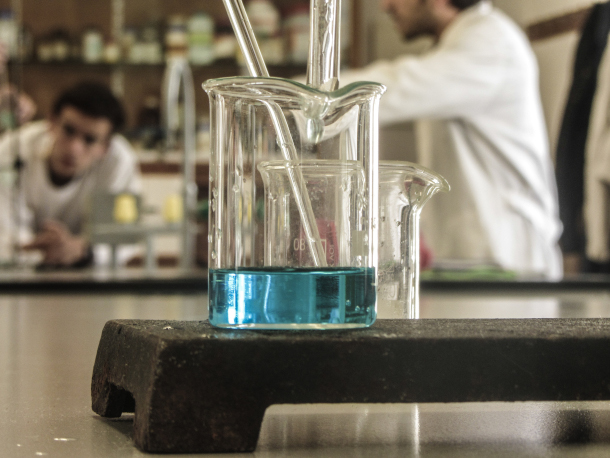
In this study researchers sampled 64 fast food items from different restaurants as well as three pairs of unused handling gloves and looked for 11 kinds of phthalates. (Photo: DisconnecTomas, Flickr, CC BY-ND 2.0)
CURWOOD: Now, not all chemicals that can make plastic soft are the same, and some, but not all, have been shown to be harmful to human health, as you say. So, what exactly, which chemicals did you find here, exactly?
ZOTA: These phthalates are, you know, several years ago, they were the dominant plasticizers used across the world. As I mentioned, they've been extremely well studied in human and animal studies. CPSC under the direction of Congress, I think about 10 years ago, passed a law restricting the use of certain phthalates like DEHP and dibutyl phthalate from children's toys. So, and those certain ortho-phthalates are also restricted by the European Union. So, there has been pressure on the private sector to begin to look for alternatives, and so we refer to these as non-phthalate plasticizers. They're still industrial chemicals, but they haven't been as well studied. You know, they may be less potent than DEHP, yet they may still contribute to negative health outcomes. And so one of the novel parts of our study, we found this rather newer plasticizer, DEHT, in fairly high concentrations, and we found it in the food, and we found it in the food handling gloves that we tested. And there's virtually no data, no toxicology data, no epidemiologic data on DEHT, currently in the peer reviewed literature, and so you know, once again, we're doing a big experiment on ourselves, where we're allowing our population to be exposed to this chemical before we really understand, you know, whether it's safe.
CURWOOD: Of the fast food you studied, how many contained the phthalates that are known to be health hazards to humans, compared to the ones which have yet to be tested?
ZOTA: We looked for 11 chemicals, we found 10 of them. So, we found virtually all of the phthalates that we were looking for in these fast food meals. The two that were most commonly detected were dibutyl phthalate and di-2 ethylhexyl phthalate or DEHP which is a particularly notorious agent. So dibutyl phthalate was detected in 81% of foods, and DEHP was detected in 70% of foods.
CURWOOD: And those chemicals are chemicals of the Consumer Product Safety Commission says should not be in children's toys at this point?
ZOTA: That is absolutely correct. Right. So, they find it concerning for them to be in children's toys, yet they are currently allowed to be used as food additives in the US as regulated by, as decided by the US FDA,
CURWOOD: Bobby Bascomb in our shop notes that in a Happy Meal for a child, it would not be okay to have phthalates in the toy, but yet it's okay to be in the burger, your thoughts?
ZOTA: I couldn't have said it better. I really couldn't have. So, hopefully, our study will help to shine a light on that and drive change so that you know when we're eating our burger, we don't have to eat plasticizers.
CURWOOD: And for the record of the plasticizers that have yet to have thorough human health reviews, what percentage of food that you tested had those?
ZOTA: Right, so, we looked at three alternate or replacement plasticizers and the one that was most ubiquitous was this DEHT. So it's a terephthalate, not an ortho-pthalate. And that was detected in 86% of the of foods. And it was also the one that was detected in all of the food handling gloves that we sampled, which we also obtained from the same restaurants where we collected the food.
CURWOOD: Are these chemicals? Are they attracted to fat? You scientists would call them lipophilic.
ZOTA: They are. That's right. But they are lipophilic, and they do bioaccumulate but not necessarily in the same way in your body. So, they're non-persistent in the body, but that is correct. So, they are more likely to be found in meats, dairies and oils. That's correct.
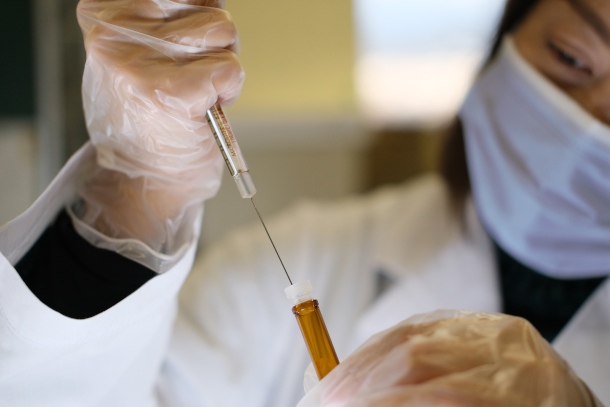
Plastics that make their way into food can come from gloves, industrial tubing, food conveyor belts and wrap packaging commonly used in fast food. (Photo: Japanese Expert, Flickr, CC BY 2.0)
CURWOOD: Tell me more exactly what you looked at, And I noticed you mentioned that food handling gloves were considered for the second phase of your study.
ZOTA: You know, we're interested in sources that wasn't the main objective of our study. But you know, ultimately, if we're trying to intervene, it's important to understand sources. And so several other studies had pointed out that these food handling gloves, which are often made of you know PVC plastic have high amounts of plasticizers, and when the gloves touch the food that plasticizer chemicals can actually migrate out of the gloves into the food, especially if that food is hot. And generally, we did find a pattern between the level of chemicals in the food in those restaurants and and what was in the gloves. But obviously, this is not a definitive analysis.
CURWOOD: What are the public health and regulatory implications of your work? Right now I don't see a label if I go to a fast food restaurant that says may contain phthalates.
ZOTA: Right, so currently, the whole class of ortho-phthalates that we are calling phthalates, as well as these replacement plasticizers, they're allowed to be used in as food additives, according to the FDA, so they're allowed to be in our gloves in our packaging, you know, in other types of plastics, like our tubing and conveyor belts, and there are no regulatory thresholds in terms of how much phthalates can be in your food. And so that would go under FDA authority, you know, allowing phthalates to be, you know, an allowable food additive. And so that's something that they're currently deciding on or considering at the moment.
CURWOOD: If I understand it correctly, it's pretty much impossible for an ordinary consumer to test food to see if it has phthalates contaminating it. So what should consumers do? What's the takeaway for consumers of fast food based on this preliminary study of yours?
ZOTA: That's right. A point you made is that while individual choice is important, we need policy solutions. I think one takeaway is that, you know, if you're eating out a lot, you are going to be increasing your exposure to these chemicals. And maybe you're fine with that, but you know, if you have vulnerable people in your family, you may want to reconsider. If you are going to eat, eat in moderation, and consider reducing your intake of meat because there, you know, there were higher amounts of these chemicals in meat.
CURWOOD: Dr. Amit Zota is a Professor of Environmental and Occupational Health at George Washington University. Thanks so much for your time today.
ZOTA: Thank you.
CURWOOD: We reached out to each of the fast-food chains cited in the study but did not get a response from any of them before our deadline. The Washington Post has quoted the FDA as saying, “Although the FDA has high safety standards, as new scientific information becomes available, we reevaluate our safety assessments.”
Related links:
- Read the study: Phthalate and Novel Plasticizer Concentrations in Food Items from U.S. Fast Food Chains: A Preliminary Analysis
- Eurekalert | “Deaths To ‘Hormone Disruptor’ Chemical Costs Millions In US Productivity”
[MUSIC: Heather Masse, “Chosen” on Bird Song, by Heather Masse, Red House Records]
CURWOOD: You can hear our program anytime on our website, or get an audio download. The address is LOE dot org. That's LOE dot O-R-G. There you’ll also find pictures and more information about our stories. And we’d like to hear from you. You can reach us at comments @ l-o-e dot org. Once again, comments @ l-o-e dot O-R-G.
Our postal address is PO Box 990007, Boston, Massachusetts, 02199. And you can call our listener line, at 617-287-4121. That's 617-287-41-21.
[MUSIC: Heather Masse, “Chosen” on Bird Song, by Heather Masse, Red House Records]
Beyond the Headlines
Scientists estimate that the North Atlantic right whale population reached a 20-year low of 336 in 2020. (Photo: New England Aquarium)
CURWOOD: Time now to speak to Peter Dykstra. Peter's an editor with the Environmental Health News. That's ehn dot org, and dailyclimate dot org. And he's on the line now from Atlanta, Georgia, where he's been looking over what's going on beyond the headlines for us. Hi there, Peter, and what do you have for us today?
DYKSTRA: Hi, Steve, a little follow up on a little bad news. We heard on last week's show that Northern right whales are getting smaller. But they've also had a couple of really, really bad years for reproduction. And the population count is as small as it's been in at least 20 years, with last year, the count being 336 Northern right whales remaining.
CURWOOD: Boy, they had gotten up to more than 400 at one point over these last 20 years. I guess those entanglements with fishing gear and collisions with ships are, are taking their toll, huh?
DYKSTRA: They are, and other possible reasons that the population is going down, despite a huge effort to make it recover are things like climate change, because once those animals are through with mating season down here off the Georgia and Florida coasts, they head north for feeding season. And climate change has affected where their food sources are. That may be a reason that the population is hurting, for an animal that got its name because it was, for whalers centuries ago, the "right whale" to kill. It was very slow, its habitat was near the coast, and when you harpooned it, and it died, it didn't sink, it floated near the surface.
CURWOOD: Yeah, well, these numbers are very disturbing, but I gather that the folks who follow the Northern right whales still feel that they have some hope. What is the source of their hope, do you think?
DYKSTRA: Well, there's so much attention on the few animals that are left that ship strikes and entanglements can be more of a focus, and the right whale to kill may be the right whale to save.
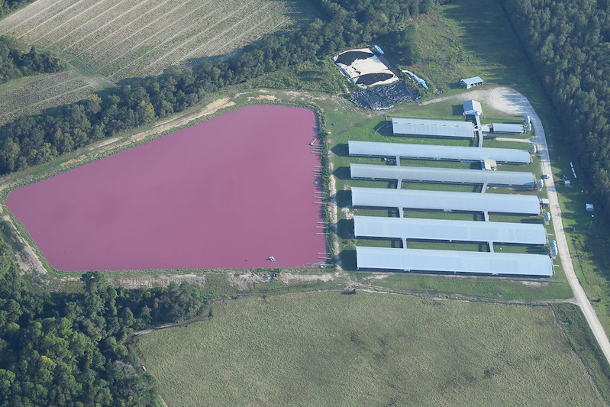
A hog CAFO (concentrated animal feeding operation) in North Carolina photographed from the air. (Photo: Matt Butler, Sound Rivers, Waterkeeper Alliance Inc., Flickr, CC BY-NC-ND 2.0)
CURWOOD: Let's hope so. Hey, what else do you have for us this week?
DYKSTRA: We're gonna talk about Carolina CAFOs, Concentrated Animal Feeding Operations. The right whales are getting smaller here in the northern hemisphere, but the hogs are actually getting larger. In North Carolina, a state already beset by water and air pollution from some of the biggest hog farms in the country, if not the world, those hog farms are getting bigger. And not only that, but they're now outnumbered by poultry farms: chickens and turkeys with many of the same pollution problems, including the smell. If you were to go down I-95 in eastern North Carolina, there are places where you just have to roll up the windows rather than endure the smell.
CURWOOD: And let me guess, in terms of environmental justice, these Concentrated Animal Feeding Operations with all the manure and such are in -- communities of color?
DYKSTRA: Pretty much so, far more so than in white communities. Eastern Carolina is a heavy farming district, it always has been. They once had a lot of tobacco farms. They've been phased out, because these hog operations are much, much bigger, in addition to the fact that tobacco is at least a little bit phased out in this country.
CURWOOD: Well, also though, meat is being questioned as a contributor to climate disruption. So I guess time will tell. Hey, Peter, what do you have for our look back into history this week? Tell me what you see.
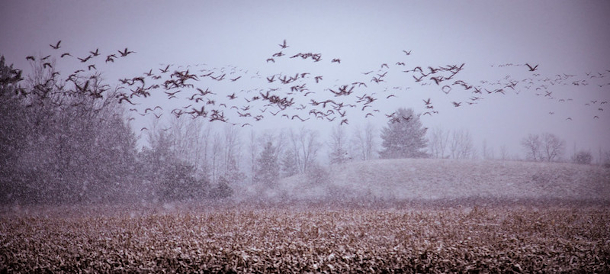
Waterfowl taking flight amid a snowstorm (Photo: Christian Collins, Flickr, CC BY-SA 2.0)
DYKSTRA: November 1, 1995, there was an early blizzard on the Canadian prairie that sparked a "Grand Passage." That's the name that's given to when all of the waterfowl, ducks and geese pack up and fly south at the same time. There were millions, an estimated 50 to 80 million ducks and geese abruptly heading south across the central US, the Mississippi River flyway. So many ducks and geese that at one point, airport radar became virtually useless. And the airports in Kansas City and Omaha had to close down because of ducks and geese.
CURWOOD: They were worried about quack-ccidents, I suppose?
DYKSTRA: Well, that would be a little daffy. But I have to say that waterfowl have prospered in the Midwest, largely due to the efforts of farmers and duck hunters and conservationists like Ducks Unlimited protecting the small ponds and the wetlands along the flyway, allowing ducks and geese to prosper to the point where they actually shut down airports.
CURWOOD: That's good news at a time when we seem to be losing so many species. Thank you so much, sir! Peter Dykstra is an editor with Environmental Health News, that's ehn dot org and dailyclimate dot org. And we will talk to you again real soon!
DYKSTRA: All right, Steve, thanks a lot, talk to you soon.
CURWOOD: And there's more on these stories on the Living on Earth webpage, that's loe dot org. And, honk if you like it.
Related links:
- About the decline in the North Atlantic right whale population
- North Carolina Health News | “Unchecked Growth of Industrial Animal Farms Spurs Long Fight for Environmental Justice in Eastern NC”
- The New York Times archive | “With Habitat Restored, Ducks in the Millions Create Fall Spectacle”
MUSIC: Peter Baum, “Bird Flight Past the Moon” on Time, self-published]
CURWOOD: Coming up – How the current energy shortage in China plays into their long term plans to reduce greenhouse gas emissions. That’s just ahead on Living on Earth.
ANNOUNCER: Funding for Living on Earth comes from you, our listeners, and United Technologies, combining passion for science with engineering to create solutions designed for sustainability in aerospace, building industries, and food refrigeration.
[CUTAWAY MUSIC: Lewis Porter-Phil Scarff Group, “Branches in the Trees” on Three Minutes To Four, by Phil Scarff, Whaling City Sound]
China’s Energy Crunch and Climate
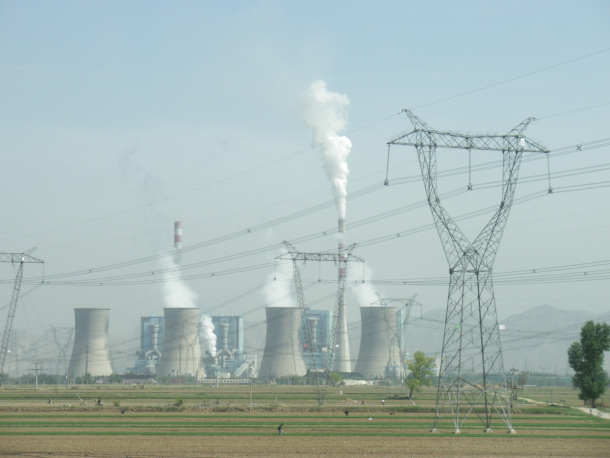
Shuozhou coal power plant. (Photo: Kleineolive, Wikimedia Commons)
CURWOOD: It’s Living on Earth, I’m Steve Curwood.
Roughly 20 Chinese provinces have recently been enduring rolling electric blackouts, and government has asked factories to operate fewer days to avoid peak power usage. In a number of places authorities have curtailed the use of elevators and traffic lights and water pumps have gone intermittent. A trade war with Australia has cut off imports of its high-grade coal to China, and military planning by the US clearly geared for a possible confrontation has Chinese leaders concerned about energy security, especially shipments of gas and oil. China does have domestic coal, and so as a result, China plans to build more coal-fired power plants. All this has an impact on China’s position at the COP26 Climate Summit in Glasgow, where all nations are being asked to up their individualized commitments to reduce climate changing emissions. Isabel Hilton is a former journalist for the BBC and the Guardian and founder and senior advisor of the China Dialogue group. She joins us on the line now from London. Isabel welcome to Living on Earth!
HILTON: Steve, it's a great pleasure to be here. Thank you for having me.
CURWOOD: Our pleasure. So the Conference of the Parties number 26, COP 26 is coming up. How do you think the energy crunch in China now is affecting their views on what they can do with this meeting?
HILTON: Well, I think I think there were two ways to look at China and climate change. One is the long term China strategy, which I'm very happy to go back to. And the second is the short term management of the situation and the expectations of COP. And of course, the big influence on the short term management has been continuing energy crisis in China, energy shortages that have affected people's everyday lives, they've affected transport, they've affected factory production. And that's something with winter approaching that clearly, the government needs to pay attention to. And that is something that has led to the opening of new coal mines or old coal mines that have been shut down. So there is a bit of a pause and reflect moment going on in China. And that will affect how they present themselves at COP.

Pollution over east China. (Photo: NASA, Wikimedia Commons, public domain)
CURWOOD: So back in 2015, just before then, the United States and China had gotten together to work out what would become the bones of the Paris Climate Agreement. This time, it seems like the United States and China well, doesn't seem to be a whole lot of dialogue on what to do at the Conference of the Parties. What's going on, in your view?
HILTON: Well, we've got a long running strategic confrontation going on between the United States and China. And you know, we it's a very long time, it seems to me politically from that moment of handshake between Xi Jinping and Barack Obama. And that was a really critical moment that pretty much allowed the Paris agreement to come into being because when the United States and China are in confrontation, as they were in Copenhagen, when there was the first attempt to bring in a new global agreement, it ended in tears, you know, nothing got done, everybody was very bruised. And it took quite a long time, and quite a different approach to bring the Paris agreement into being that different approach was to say to all the signatories, this is not a top down agreement, it's a bottom up agreement you bring to the table, what you can bring the nationally determined contributions, we will add them up and in five years time, we will ask you to make them more ambitious. And that's where we are. That's what COP 26 is about. So we're not negotiating a new deal in Glasgow, but we are trying to ensure that the deal that was negotiated in Paris functions that it works that it does what it's meant to do, which is to keep the ambition of keeping global average temperature rises below 1.5 °C. Keeping that possible.
CURWOOD: So now it's time for countries to bring their Nationally Determined Commitments to the table out of Paris. How does the situation between the United States and China affect what each of these nations is now willing to commit to your thing?
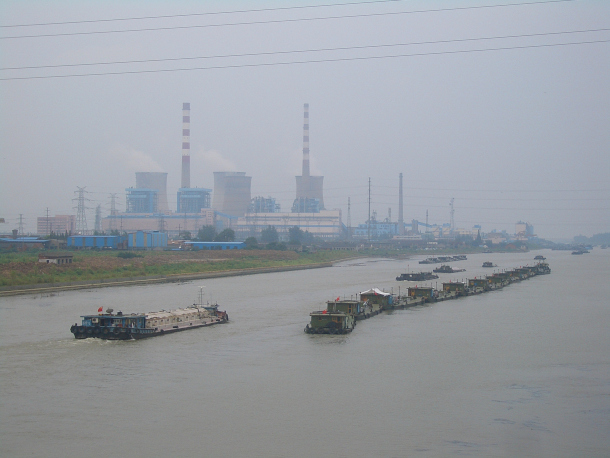
Barges move through China’s Grand Canal. (Photo: Vmenkov, Wikimedia Commons, CC BY 3.0)
HILTON: Well, it affects it in a number of ways. You know, after the US and China agreed to work towards Paris, they set up a whole bunch of cooperation mechanisms. So cities were talking to cities in the different countries, states were talking to provinces, they were working out collaborative ways of advancing a climate agenda. And pretty much that all stopped when President Trump took office. And remember, the United States withdrew from the Paris Agreement. So there was a pause, in which, you know, everyone looked to China who said, no, we're staying in, we will carry on doing what we're doing. So there is a steadiness of commitment in China, as far as as climate goes, you can argue about how fast or how slow they're, they're going, but at least they stay in the process. So now the United States is back. And that's great. But the geopolitical tensions mean, that those cooperations that web of that network of collaboration that we had, between the United States and China, is pretty thin. What remains, however, is a personal friendship between John Kerry and Xie Zhenhua, his Chinese counterpart, Poor Xie Zhenhua keeps trying to retire and he keeps getting brought back, because he's such an old hand at COPs, and everybody knows and trusts and likes him. And he has the ear of Xi Jinping. So this is a very good thing. So Xie Zhenhua and John Kerry have been calling each other and meeting and you know, getting done what they can get done, in spite of the very chilly atmosphere that surrounds the US China relationship. However, there's one important thing I think it's worth noting that, given that we're in an uncertain world, and if you're China, you're looking at this hostility as they see it, you know, from the United States and its allies. And you're thinking, well, if something kicks off in the region, you know, What happens to our energy supplies because most of China's energy supplies come in by ship. They're mostly oil and gas are coming in. And there's a choke point called the Malacca Straits, which is highly vulnerable. So the nightmare for an energy security planner in China is that those supplies get interrupted. And then you look at okay, what else have we got? Well, we have some pipelines that come in from Russia. And across Myanmar, Lashio pipeline bringing oil and gas, and we're building a corridor that will bring stuff in from the Gulf through Pakistan up to western China. But essentially, what we have at home, what we can rely on is coal. And so for climate reasons, we want China to stop using coal. But for security reasons, particularly in the global context, China's just hanging on to coal right now.
CURWOOD: So another way of putting this if the world felt very peaceful right now, we might be making advances more advances in terms of dealing with the climate. How fair is that to say?
HILTON: I think without question, yes. I mean, you know, you remember that Xi Jinping made an announcement, a virtual announcement at the UN General Assembly in 2020, which, for the first time set a target for China, of net zero by 2060. And that he would peak emissions by 2030. This came as a bit of a surprise to a lot of his own officials, because suddenly he made this big dramatic announcement. So they then kind of scrambled about putting the policy in place to deliver on these promises that their leader had made. So we all looked at the 14th five year plan, which was published the following March, with some interest to see how they were going to do it. And everyone was rather surprised that that pledge that 2060 pledge, only got one mentioned in the 14 five year plan. And what was mentioned far more in all the speeches around these big important political meetings that happened in China in March every year was energy security. And that's just that just flags up, the way external circumstances impact domestic thinking.
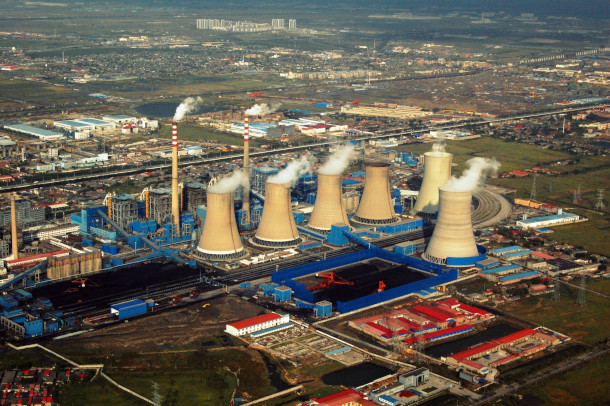
The Jungliangcheng power plant in Tianjin, China. (Photo: Shubert Ciencia, Wikimedia Commons, CC BY 2.0)
CURWOOD: Let's talk about the current shortage of electricity in China right now. I understand that factory production is getting cut, there are even some limits on daily use of of elevators, there's more coal being produced, what's happening in the different regions of China? I’m wondering also between South and North as well.
HILTON: Well, that's a wonderful kind of perfect storm, if you like in China. So you know, we've, as we know, we are emerging, we hope from a global pandemic. So globally, energy demand was way down, and prices were way down. And factory production was way down and consumption, everything was down. But it begins to revive as countries come out of their lockdowns. And, you know, people look around and start to normalize life again. And in China, which locked down rather less actually than many other countries, export demand began to rise and domestic demand began to rise. So energy demand begins to rise. But at the same time, energy supply, the supply, particularly of coal in China had dropped because on a separate program, the government was trying to create greater efficiencies and to restrict emissions. So that meant that the use of coal was already beginning to be restricted. And in addition, they were closing down some old and dangerous coal mines. And so this was part of a general program to take, you know, coal gradually out of the primary energy mix. So you know, the energy demand went up 17%. And coal production only went up about 6%.
CURWOOD: And if you want to buy it from overseas, you have to go to Australia, things don't seem to be going very well, between China and the Australians these days.
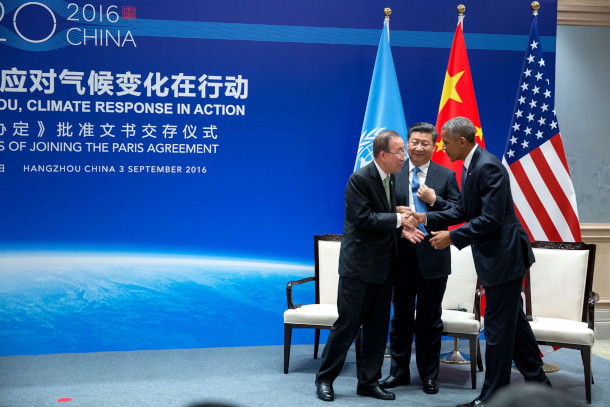
Ban Ki-moon, Xi Jinping and Barack Obama greet each other at a climate event in Hangzhou in 2016. (Photo: White House, Wikimedia Commons, public domain)
HILTON: Well, things have gone very badly with Australia so badly that the very high grade Australian coal that China used to buy had been you know, nixed by the Chinese government to punish Australia. That wasn't a huge proportion of the coal imports. But it was important because it was high grade. But then if you look around the global market, coal prices have gone through the roof. So if you're a Chinese coal fired power station, looking for coal, you are going to have to pay three times as much for Indonesian coal, as you had, you know, last year, but you couldn't move your prices. So it was a clash between, you know, the free market, which was operating and global energy prices, and the restrictions of the planned economy that operates in the Chinese grid and the Chinese electricity system. So the poor guys who are supposed to be generating the electricity, we're looking at a situation in which they were just generating massive losses. So in order to survive, they said, well, we'll still supply electricity, but not that much. So they restricted their supply in order to control their losses. And that meant that there's just not enough to go round as all this demand is surging. So, you know, people suddenly found that, you know, they live in multi story buildings and the elevators didn't work anymore. It happened very quickly, these rolling carts, factories couldn't meet their orders, you know, even traffic lights and hospitals were having supplies cut. And part of that there's another last element in this, which is I mentioned those targets for efficiency, which are part of the long term climate targets. You know, as you come to the end of a planning period, all Chinese officials who have these targets in their, you know, work plan, are desperate to meet them, because if you don't meet them, it's a black mark for your promotion. So they tend to go to rather extreme measures in order to meet the target. And we have seen, even without a supply crunch, we have seen in the past energy simply being cut, because it will get them in under the wire for the close of the planning period, and they meet their targets. No other reason, just just because that's how the planning system works.
CURWOOD: Why do you think the energy crisis won't affect the long term approach to the climate in China?
HILTON: I don't think it will. Because China's approach to climate goes back a long way. China's climate risk is huge. I mean, if you think of the where all the development takes place, or took the early development took place, it was along that East Coast, big Delta cities like Shanghai, Tianjin, and Guangzhou, huge, hugely sophisticated and important industrial sites, big population centers. And all of China's a major rivers derive from the ice and snow in the Himalaya, which is melting very fast. So clearly, China has enormous vulnerabilities. And the other factor was that the there was an environmental crisis in China, which was expressed in terrible air pollution, water pollution, soil pollution. And that was the product of 30 years of catch up industrial production, which had delivered a lot in terms of, you know, raised income levels, and much more sophisticated urbanization, and all of that was fine. But it was also exhausted, it was, you know, other other Asian Tigers had done this. So Taiwan and South Korea and Japan, they all follow the same model, you do very rapid growth, low added value, quite wasteful, but rapid production. So you get your rural population into factories, and that's your first stage of development. When you get to the point where that no longer works, you have to move up the value chain. So you start, you know, if you're Taiwan, you start making television sets or computers, or, you know, instead of t shirts and cigarette lighters, so China was at that point when it was running out of steam in the old model. And to move up the technology value chain, it looked at what the technologies of the future would be, and identified very quickly, low carbon technologies. So they invested enormously in everything to do with climate change. So wind power, solar power, nuclear power, big dams, electric vehicles, rarus, absolutely everything you need to transform your industrial economy to service climate action. And they've been doing that for nearly 15 years now. So once you've built your industrial strategy, on the need for an energy transition on the recognition that climate change is a massive threat. And you have built a strategy, which allows you to be the supplier of goods and services to a world that is trying to battle climate change. You don't change that tomorrow, you don't change that just because you're short of coal this week. You know, that is a long term plan strategy. And that's where China has bet its future.
CURWOOD: Let's circle back now then to COP 26. This UN Climate Summit, given the conditions that China is dealing with right now, what do you think they're going to put on the table? At this meeting, I gather that Xi Jinping is not going to come himself to Glasgow, Scotland.

Wind turbine on Mount Langshan, Hunan, China. (Photo: Huangdan2060, Wikimedia Commons, CC BY 3.0)
HILTON: I think what we'll see is not so much a great revision of targets, although China does still promise a new NDC a new nationally determined contribution. There is some wiggle room, for example, the 2030 target, which is the date at which China has promised to peak its emissions. That target was on the table in Paris six years ago, it was regarded as pretty loose then and there is still room inside that target for China to bring it forward. So China quick turn up and say look, we are bringing forward our peaking date to 2028 or even 2025. That would make an enormous difference. Because the earlier we all act and we really really have to you know get things going before 2030 because after that, it becomes very difficult. So if China were to do that, it would certainly gain a lot of approval, and it would also help the negotiations. What I think China will also do is point to the announcements already made. So the 2060 target, but also the promise not to build any new coal outside China anymore. So no more coal on the Belton Road, that's a relatively easy thing to do. China will also promise to help instead of building coal, to help other countries build renewable systems. And so helping them to leapfrog that high emitting phase that has been the default assumption of any industrializing country. And that's also extremely important because there's a lot of potential out there for high emissions in countries that have yet to industrialize. And it's very important that we all assist them to do that.
CURWOOD: Isabel Hilton is founder and Senior Advisor of China dialogue.net. Thank you so much for taking the time with us today, Isabel.
HILTON: Steve. It's been a real pleasure. Thank you for having me.
Related links:
- The Guardian | “China’s Plan To Build More Coal-Fired Plants Deals Blow to UK’s Cop26 Ambitions”
- About Isabel Hilton
- ChinaDialogue.net
[MUSIC: Derek Fiechter, “Imperial Dynasty” on Ancient Legends]
CURWOOD: Living on Earth is produced by the World Media Foundation.
Our crew includes Naomi Arenberg, Bobby Bascomb, Paloma Beltran, Jenni Doering, Jay Feinstein, Mark Seth Lender, Don Lyman, Aynsley O’Neill, Jake Rego, Genevieve Santilli, Teresa Shi, Gabriell Urton, and Jolanda Omari. Tom Tiger engineered our show. Special thanks this week to Destination Wildlife. Alison Lirish Dean composed our themes. You can hear us anytime at L-O-E dot org, Apple Podcasts and Google Podcasts, and like us, please, on our Facebook page - Living on Earth. We tweet from @livingonearth. And find us on Instagram at livingonearthradio. I’m Steve Curwood Thanks for listening!
ANNOUNCER: Funding for Living on Earth comes from you, our listeners, and from the University of Massachusetts, Boston, in association with its School for the Environment, developing the next generation of environmental leaders. And from the Grantham Foundation for the protection of the environment, supporting strategic communications and collaboration in solving the world’s most pressing environmental problems.
ANNOUNCER 2: PRX.
Living on Earth wants to hear from you!
Living on Earth
62 Calef Highway, Suite 212
Lee, NH 03861
Telephone: 617-287-4121
E-mail: comments@loe.org
Newsletter [Click here]
Donate to Living on Earth!
Living on Earth is an independent media program and relies entirely on contributions from listeners and institutions supporting public service. Please donate now to preserve an independent environmental voice.
NewsletterLiving on Earth offers a weekly delivery of the show's rundown to your mailbox. Sign up for our newsletter today!
 Sailors For The Sea: Be the change you want to sea.
Sailors For The Sea: Be the change you want to sea.
 The Grantham Foundation for the Protection of the Environment: Committed to protecting and improving the health of the global environment.
The Grantham Foundation for the Protection of the Environment: Committed to protecting and improving the health of the global environment.
 Contribute to Living on Earth and receive, as our gift to you, an archival print of one of Mark Seth Lender's extraordinary wildlife photographs. Follow the link to see Mark's current collection of photographs.
Contribute to Living on Earth and receive, as our gift to you, an archival print of one of Mark Seth Lender's extraordinary wildlife photographs. Follow the link to see Mark's current collection of photographs.
 Buy a signed copy of Mark Seth Lender's book Smeagull the Seagull & support Living on Earth
Buy a signed copy of Mark Seth Lender's book Smeagull the Seagull & support Living on Earth

